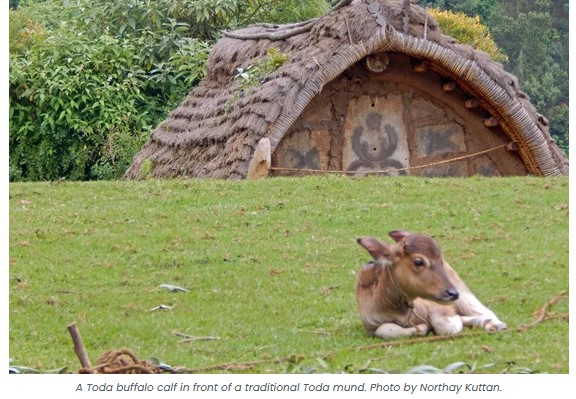Conserving ‘Toda Buffalo’ – Named After ‘Toda Tribe’
- Polker Kuttan, a 72-year-old Toda tribal from the Nilgiris, is like a local weather expert – he can predict the onset or delay of the seasonal rains and even the duration of each spell. Polker says that just a whiff of the flowers found in the mund (Toda settlements) would tell him when the next rain spell is bound to happen.
- He observes how the rains and their lives have become unpredictable in recent times. “In the last 15 years, everything has changed. The flowers are disappearing and so are the honey bees. We used to collect honey during the summer, but it has become increasingly difficult,” he said.
- But the change that hits him the hardest is the disappearance of their beloved Toda buffaloes. These buffaloes, so named for their close association with the tribe, are a breed of the Asiatic water buffalo (Bubalus bubalis).
- Polker says the buffaloes have reduced to one-tenth of the original population in their villages. A 2013 livestock breed study revealed that the population of pure breed Toda buffalo totaled 3003.
- “Even the milk yield, which was 5 litres per day per buffalo, has reduced to 1 litre per day. This is primarily because their grazing lands have reduced drastically,” he added.
- The close-knit Toda communities live in settlements called munds across the Nilgiris. With many Todas moving out for jobs, only 65 munds remain. Each mund has around 4-10 homes, one or two temples and a buffalo pen near their abode.
- For elderly Todas like Polker, the drastic drop in Toda buffalo numbers doesn’t just translate as loss of livelihood. The Toda buffaloes are also an essential part of their culture. The Todas traditionally categorise their buffaloes as sacred and secular and they even have specific dairy temples for different hierarchies of their sacred buffaloes. From birth to death, the Todas rely on these dairies and the Toda buffaloes for every ritual.
- Northay Kuttan, President, Nilgiris Primitive Tribal People’s Federation explained, “Todas are very connected to nature. Even our chants are names of nearby mountains, rivers, trees, etc. And the Toda water buffaloes are the crux around which our life revolves. We open our temples only when the sacred buffaloes birth a calf. We have to use its milk to churn butter and ghee (clarified butter). This ghee is then used to light the lamp in our temple. If the buffaloes do not reproduce, our temples will remain closed.”
- Hence, the Toda buffaloes’ disappearance also directly threatens to dissipate the ancient culture of this tribe.
- As per the Central Institute for the Research on Buffaloes, “The existence of this buffalo could be traced back from the earliest reference of Finicio (1603) who wrote of the tribe: “They have no crops of any kind, and no occupation but the breeding of buffaloes, on whose milk and butter they live”. Apart from the Todas, who predominantly own these buffaloes (hence named after the tribe), other communities such as Badagas and Kotas also maintain them in small numbers.”
- Ramakrishnan, Assistant Professor in Wildlife biology, Government Arts College, Ooty, observes that Toda buffaloes are characterised by crescent-shaped horns and short legs, and are ferocious and semi-feral in nature.
- “The drastic reduction in their population is worrisome. The numbers are close to only 50 buffaloes in a mund now,” he said.
- He opines that this could be because of the successful tiger conservation programme in the region that has led to an increase in the tiger population, which in turn has reduced the buffaloes it preys on.
- “With the buffaloes’ traditional grazing lands replaced by plantations and farms in the Nilgiris, they go into the forests where they increasingly fall prey to the tigers,” he said.
- He recalls how a government initiative helped to build a “buffalo pool” to help the Todas replace the buffaloes killed by tigers so as to alleviate any financial burden on the herders.
- “This would definitely help temporarily. But in the long run, increasing the native grasslands (for grazing) in Nilgiris would be the only way to protect the remaining buffaloes,” concludes Ramakrishnan.
Resurrecting the native grasslands
- Godwin Vasanth Bosco, an ecologist and writer based out of the Nilgiris, agrees that reviving the grasslands is crucial to the conservation of the Toda buffaloes and other grassland-dependent species like the Nilgiri Tahr. However, both the British and the post-independence government policies have treated the native grasslands like wastelands, replacing them with what was perceived as more ‘productive’ exotic species like Eucalyptus or wattle (for the paper industry).
- Conservationists and scientists have proven the importance of native grasslands for various endemic species in the region, including the Toda buffaloes. Last year, the Madras high court had intervened and formed a committee to remove invasive species such as Lantana camara and revive the native shola forests and grasslands in the Nilgiris.
- Vasanth tells us that only 9 -10 percent of the native grasslands remain in the Nilgiris. “It would take careful removal of invasive species and replacing it with plugs of native grasses in suitable areas to revive these grasslands,” he said. His organisation, Upstream Ecology, along with Keystone Foundation, has worked on select Toda munds for reviving various native grass species.
- He tells us that another larger challenge is that many landowners in Nilgiris (including pastoralists like Todas) lease out grasslands to farmers for growing vegetables. Toda leader Northay Kuttan, who has also taken initiatives to conserve native trees and grasslands for close to two decades, understands that there are challenges that arise from both within and outside his community. He believes that it would indeed take a large-scale coordinated effort by the natives, NGOs and the forest department to bring back the lost grasslands of their hamlets.
Preserving the genetic pool of the Toda buffaloes
- While efforts to revive native grasslands continue, Dr. Anil Kumar, Professor and Head at the Sheep Breeding Research Station in the Nilgiris, has been directly involved in conserving the Toda buffaloes.
- “There are only around 1000 bulls in the Nilgiris. The Toda buffaloes are a unique breed of buffaloes that can survive the harsh climate conditions of Upper Nilgiris and are also highly disease-resistant. We have taken consistent efforts to ensure that the germplasm of this native breed isn’t lost. We have observed that the Toda bulls are mostly feral, they stay in the forests and come out only during the breeding season. In most of the herds, the number of calves had reduced due to the paucity of bulls. We have not only reared and studied 18 buffaloes in our farm and returned it to the Todas, but have also trained around 30 Toda youth on first aid, ethnoveterinary practices, vaccines and other ways to prevent calf mortality,” he said.
- “The Jallikattu protest in Tamil Nadu brought huge focus into the conservation of native cattle. There is a sudden surge of interest in native cattle milk. If we can find a better market value for this rich Toda buffalo milk (Toda buffalo milk has 12 percent fat, as compared to 8 percent fat in normal cows), more and more Todas would come forward to protect these native cows,” he added.
- And this is precisely what Toda leader Northay is attempting, “We have sent a proposal to the Tribal Welfare department to market the ghee of our native Toda buffaloes under a tribal brand and are awaiting approval. We have plans to test this organic ghee to understand its properties better and to help our product reach a wider market.”
- Northay reveals that Nilgiris heritage and culture society, which he heads, is also planning to breed a pool of pure Toda buffaloes for their temples. It would be a non-profit initiative to conserve their culture.
- “There are also plans to use leaf culture, a unique technique to propagate plants using their leaves, with the help of agro-scientists in Coimbatore, to revive native grasslands as grazing lands for our buffaloes,” said Northay, who is leaving no stone unturned to protect what is left of the Toda buffaloes and their culture.




